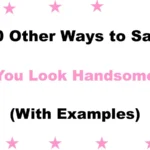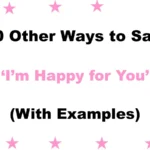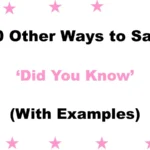Finding the right words can instantly shift how your message is received. Saying “stay tuned” is common, but sometimes you want to sound more thoughtful, professional, or human—especially in emails, updates, or business communications. Whether you’re sharing exciting news, giving project updates, or keeping a team engaged, the phrasing matters.
The alternatives below help you sound caring, clear, and warm, without losing the essence of staying connected. Let’s explore 30 meaningful alternatives to “stay tuned” that elevate your message with professionalism and empathy.
What Does “Stay Tuned” Mean?
“Stay tuned” is a casual phrase that means “keep paying attention because more information is coming soon.” Originally from radio and television broadcasting, where listeners were asked to “stay tuned” to the same channel for updates or upcoming segments, the phrase has evolved into everyday use.
Today, it’s commonly used in emails, marketing, social media, and casual conversations to let someone know that they should expect a follow-up, announcement, or further development. It carries a friendly, slightly informal tone and helps build anticipation without revealing everything at once.
When to Use “Stay Tuned”
- To tease upcoming announcements or updates
- When delaying information but maintaining interest
- At the end of marketing or newsletter content
- During event planning or launch campaigns
Is It Professional/Polite to Say “Stay Tuned”?
Yes, “stay tuned” can be both professional and polite—when used in the right context. It strikes a balance between being friendly and engaging, especially in emails, presentations, and newsletters. While it leans slightly informal, it’s widely accepted in industries like marketing, tech, education, and media to keep the tone warm yet focused.
However, in highly formal communications—like legal notices or executive memos—it’s better to use a more formal alternative. Overall, “stay tuned” works well when your goal is to keep your audience interested, informed, and connected without sounding too stiff or robotic.
Pros and Cons of Saying “Stay Tuned”
Pros:
• Easy to understand
• Builds curiosity
• Encourages engagement
• Sounds modern and friendly
Cons:
• Can sound too vague
• Overused in digital spaces
• Not always suited for formal writing
Synonyms for “Stay Tuned”
- More to come soon
- We’ll follow up shortly
- Updates will be shared soon
- Keep an eye out
- Stay connected
- We’ll be in touch
- More details to follow
- Await further updates
- Watch this space
- News is on the way
- We’ll circle back soon
- Details coming your way
- Follow along for more
- There’s more ahead
- We’ll keep you informed
- Next steps are coming
- Information forthcoming
- Stay in the loop
- Further communication to come
- Continued updates expected
- Keep checking in
- Our next update is coming
- Please await our update
- We’ll keep you posted
- A full update is coming
- Watch for further developments
- Stay alert for news
- We’ll reconnect soon
- Ongoing communication ahead
- Look out for our message
1. More to come soon
Definition: Signals that additional information is on its way shortly.
Detailed Explanation: This phrase conveys anticipation and ensures your reader knows the message is not yet complete.
Scenario Example: The campaign is launching in phases—more to come soon.
Best Use: Project updates, marketing materials.
Worst Use: Legal notices.
Tone: Warm, encouraging, and forward-looking.
2. We’ll follow up shortly
Definition: Suggests a follow-up message or action will occur soon.
Detailed Explanation: A respectful and clear way to inform your audience you’ll be reaching out again.
Scenario Example: We’re reviewing your request—we’ll follow up shortly.
Best Use: Customer support, professional replies.
Worst Use: When timelines are undefined.
Tone: Professional, courteous, and direct.
3. Updates will be shared soon
Definition: Communicates that more information is on its way.
Detailed Explanation: Keeps stakeholders informed without giving too much away.
Scenario Example: The new policy is being finalized—updates will be shared soon.
Best Use: Formal team announcements.
Worst Use: Creative or playful messaging.
Tone: Neutral, professional, and clear.
4. Keep an eye out
Definition: Encourages attentiveness to future updates.
Detailed Explanation: Adds a friendly tone and implies something interesting is coming.
Scenario Example: We’re almost ready to go live—keep an eye out.
Best Use: Product launches, team messages.
Worst Use: Legal or official documents.
Tone: Casual, inviting, and upbeat.
5. Stay connected
Definition: Encourages ongoing communication or engagement.
Detailed Explanation: Implies a two-way relationship—useful for team culture or external audiences.
Scenario Example: There’s more insight coming—stay connected.
Best Use: Brand communications, email campaigns.
Worst Use: Time-sensitive updates.
Tone: Warm, collaborative, and supportive.
6. We’ll be in touch
Definition: Tell the recipient you’ll reach out again soon.
Detailed Explanation: A classic, polite phrase often used in formal or follow-up scenarios.
Scenario Example: Thanks for your patience—we’ll be in touch by Friday.
Best Use: Professional responses, client communication.
Worst Use: Creative campaigns needing urgency.
Tone: Respectful, calm, and polished.
7. More details to follow
Definition: Indicates that further information is on the way.
Detailed Explanation: A very standard, professional phrase often used in business reports or planning emails.
Scenario Example: The official timeline is under review—more details to follow.
Best Use: Internal communications, formal updates.
Worst Use: Informal blog or social posts.
Tone: Neutral, structured, and informative.
8. Await further updates
Definition: A formal way to say that more information is expected soon.
Detailed Explanation: This phrase is direct and conveys that the current message is not final, with future clarification on the horizon.
Scenario Example: We’ve submitted the proposal—await further updates from the review board.
Best Use: Business memos, official status reports.
Worst Use: Marketing or customer engagement where warmth is needed.
Tone: Formal, clear, and structured.
9. Watch this space
Definition: Suggests exciting developments are expected in the near future.
Detailed Explanation: A playful, yet informative way to build curiosity, often used in creative or promotional content.
Scenario Example: A big surprise is coming soon—watch this space!
Best Use: Newsletters, marketing, social media.
Worst Use: Legal correspondence.
Tone: Casual, engaging, and optimistic.
10. News is on the way
Definition: Tells the audience that a communication or update is coming shortly.
Detailed Explanation: A gentle prompt to prepare readers or listeners for fresh updates or exciting developments.
Scenario Example: We’re putting the final touches on the design—news is on the way.
Best Use: Email updates, company news, stakeholder communications.
Worst Use: Formal meetings or documentation.
Tone: Friendly, upbeat, and conversational.
11. We’ll circle back soon
Definition: Suggests a return to the topic of conversation shortly.
Detailed Explanation: This phrase shows intentional follow-up, often used to maintain transparency and engagement.
Scenario Example: We’re discussing internally—we’ll circle back soon with a plan.
Best Use: Project updates, team check-ins.
Worst Use: When urgency or action is required.
Tone: Warm, communicative, and reassuring.
12. Details coming your way
Definition: Promises that information will be delivered soon.
Detailed Explanation: Keeps the tone light and friendly while implying that communication is in motion.
Scenario Example: Thanks for your interest—details coming your way shortly.
Best Use: Client-facing emails, social posts, event updates.
Worst Use: Legal statements or operations documents.
Tone: Positive, modern, and informal.
13. Follow along for more
Definition: Encourages continued attention and engagement with updates.
Detailed Explanation: Often used in content marketing or social media to encourage active interest.
Scenario Example: We’re just getting started—follow along for more exciting updates.
Best Use: Blogs, campaigns, newsletters.
Worst Use: Executive briefings.
Tone: Engaging, modern, and energetic.
14. There’s more ahead
Definition: Hints at future development or continuation.
Detailed Explanation: This phrase communicates ongoing progress or evolving information.
Scenario Example: We’ve made strong progress—there’s more ahead in the pipeline.
Best Use: Team updates, business storytelling.
Worst Use: Emergency updates.
Tone: Inspiring, hopeful, and reassuring.
15. We’ll keep you informed
Definition: Shows a commitment to transparency and communication.
Detailed Explanation: Highly professional, this phrase demonstrates accountability and clarity.
Scenario Example: We’re monitoring the situation closely—we’ll keep you informed.
Best Use: Client service, HR updates, medical or technical fields.
Worst Use: Informal chats.
Tone: Trustworthy, professional, and calm.
16. Next steps are coming
Definition: Indicates actions or instructions will be shared soon.
Detailed Explanation: Often used in project or planning contexts, this phrase adds structure and direction.
Scenario Example: We’ve completed phase one—next steps are coming by Friday.
Best Use: Internal teams, client onboarding.
Worst Use: Social media updates.
Tone: Organized, process-oriented, and optimistic.
17. Information forthcoming
Definition: A more formal way to say more details are coming.
Detailed Explanation: Suited to business documents, this phrase keeps tone objective and clean.
Scenario Example: Budget allocations are under review—information forthcoming soon.
Best Use: Reports, formal communication.
Worst Use: Casual conversation or brand voice.
Tone: Serious, clear, and professional.
18. Stay in the loop
Definition: Encourages ongoing involvement or awareness.
Detailed Explanation: This friendly phrase invites readers to remain engaged and updated.
Scenario Example: For the full event rundown—stay in the loop with our email list.
Best Use: Team updates, campaigns, branding.
Worst Use: Corporate legal communication.
Tone: Casual, inclusive, and positive.
19. Further communication to come
Definition: Signals that a follow-up message or announcement will be made.
Detailed Explanation: Professional and respectful, this phrase ensures no one feels left out or forgotten.
Scenario Example: We’re gathering final data—further communication to come early next week.
Best Use: Status emails, administrative updates.
Worst Use: Social or promotional writing.
Tone: Calm, professional, and clear.
20. Continued updates expected
Definition: Indicates that updates will keep flowing over time.
Detailed Explanation: Good for ongoing projects or long-term planning.
Scenario Example: We’re in phase one—continued updates expected throughout the month.
Best Use: Construction, tech, or research timelines.
Worst Use: Urgent announcements.
Tone: Structured, steady, and dependable.
21. Keep checking in
Definition: A casual request to revisit for new updates.
Detailed Explanation: Works well for digital content or community-driven updates.
Scenario Example: We’ll be posting more info soon—keep checking in for new features.
Best Use: Websites, blog content, community pages.
Worst Use: Financial or legal content.
Tone: Laid-back, casual, and friendly.
22. Our next update is coming
Definition: Informs the audience that another update is scheduled.
Detailed Explanation: Provides assurance that follow-up will happen on a timeline.
Scenario Example: Thanks for your feedback—our next update is coming later this week.
Best Use: Product teams, SaaS, user engagement.
Worst Use: General PR statements.
Tone: Timely, organized, and proactive.
23. Please await our update
Definition: A formal phrase requesting patience until the next communication.
Detailed Explanation: Best used in settings that require composure and order.
Scenario Example: The decision is under review—please await our update.
Best Use: HR communications, legal, or academic environments.
Worst Use: Marketing.
Tone: Formal, respectful, and composed.
24. We’ll keep you posted
Definition: A friendly phrase meaning you’ll send new information soon.
Detailed Explanation: Often used in professional-casual exchanges, especially internally.
Scenario Example: We’re coordinating with partners—we’ll keep you posted.
Best Use: Internal teams, client updates.
Worst Use: Strict business memos.
Tone: Relaxed, friendly, and direct.
25. A full update is coming
Definition: Indicates a complete message or briefing is being prepared.
Detailed Explanation: Used to reassure audiences that a comprehensive answer is on the way.
Scenario Example: We’ve gathered your questions—a full update is coming this Friday.
Best Use: Event recaps, product launches, Q&A.
Worst Use: Very brief or placeholder responses.
Tone: Clear, thoughtful, and informative.
26. Watch for further developments
Definition: Encourages vigilance for evolving situations or updates.
Detailed Explanation: Implies that changes are likely and that more clarity will come.
Scenario Example: The policy is still in flux—watch for further developments.
Best Use: Change management, PR, HR.
Worst Use: Playful or casual messaging.
Tone: Serious, structured, and alert.
27. Stay alert for news
Definition: Encourages anticipation of upcoming information.
Detailed Explanation: Adds a sense of timeliness and importance to your message.
Scenario Example: We’re preparing a major release—stay alert for news next week.
Best Use: IT, security, or urgent updates.
Worst Use: Everyday project messages.
Tone: Focused, urgent, and intentional.
28. We’ll reconnect soon
Definition: Signals that contact or communication will resume.
Detailed Explanation: Friendly and human—useful in maintaining relationship continuity.
Scenario Example: We’ll review everything and we’ll reconnect soon with options.
Best Use: Networking, coaching, or sales.
Worst Use: Time-critical briefings.
Tone: Caring, warm, and collaborative.
29. Ongoing communication ahead
Definition: Suggests that updates or dialogue will continue regularly.
Detailed Explanation: Offers assurance that you’re keeping communication active and transparent.
Scenario Example: This is just the beginning—ongoing communication ahead as we move forward.
Best Use: Client partnerships, leadership updates.
Worst Use: One-time announcements.
Tone: Trust-building, consistent, and proactive.
30. Look out for our message
Definition: Alerts someone to be ready for an incoming update.
Detailed Explanation: Builds anticipation and prompts the recipient to be attentive.
Scenario Example: We’ll finalize things shortly—look out for our message on Monday.
Best Use: Email marketing, CRM follow-ups.
Worst Use: Internal announcements that don’t need urgency.
Tone: Alert, actionable, and polite.
Conclusion
Choosing the right words makes your communication feel intentional, personal, and clear. While “stay tuned” works in many cases, rotating in more specific or polished phrases helps you show respect for your audience’s time and attention.
Whether you want to sound professional, encouraging, or enthusiastic, these 30 alternatives give you a reliable toolkit for keeping your message fresh and thoughtful.
FAQs
1. Can I use “stay tuned” in corporate communication?
Yes, but it depends on the tone. If your brand voice is friendly or conversational, “stay tuned” works well. For formal updates, consider “more details to follow.”
2. What’s the most formal alternative to “stay tuned”?
“Further communication to come” or “await further updates” are ideal for formal use.
3. Which alternative sounds most friendly and human?
“We’ll keep you posted” or “we’ll be in touch” strike the right balance of warmth and clarity.
4. Are these phrases suitable for client updates?
Absolutely. Use alternatives like “we’ll follow up shortly” or “next steps are coming” to maintain professionalism.
5. How do I pick the best phrase for my situation?
Think about your audience, purpose, and tone. Choose based on formality and the emotion you want to convey—whether it’s urgency, care, or anticipation.

Mia Rose is a passionate Language Coach and Contributor at GrammarPeaks, where she specializes in practical grammar tips and language learning strategies. With a strong foundation in education and communication, Mia brings a friendly, approachable style to her writing. Her goal is to make complex grammar rules simple and usable for learners at any level, helping them grow in both confidence and fluency.





